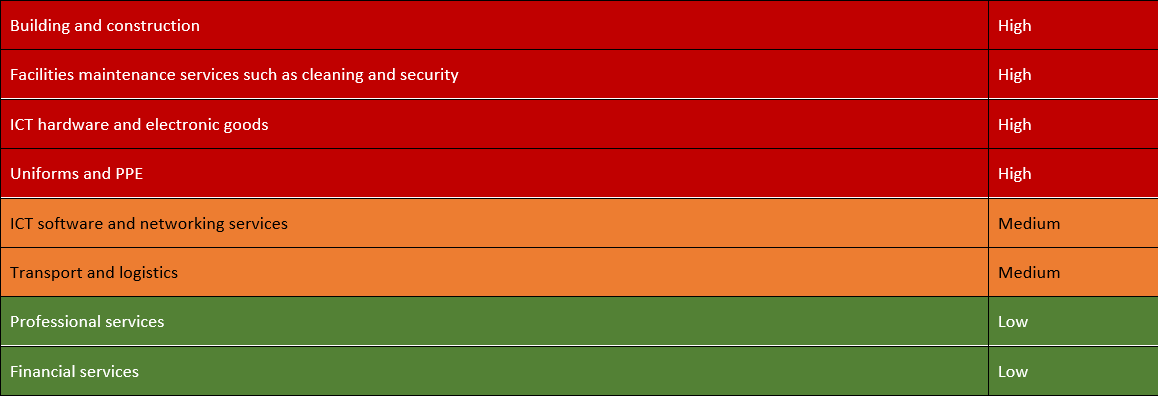Using Data to Assess Supply Chains for Modern Slavery Risk
‘How much risk do we have?’
‘Which spend categories and suppliers do we need to look at?
‘How far along our supply chain should we look?’
These and other questions are commonly asked by procurement teams struggling to understand the legislative reporting requirements and how best to assess and address their supply chain risks. Our Supply Chain Risk Assessment process provides answers to these questions and helps to reassure procurement professionals that the information they already have can provide significant insights into risk levels.
Our proven Supply Chain Risk Assessment process, developed and continuously improved through working with a diverse range of reporting entities over the last five years, assesses potential risk associated with spend across different categories of goods and services. Importantly, the initial assessment identifies potential modern slavery risk, not actual risk associated with each supplier. Determining actual risk requires an enhanced due diligence approach through the collection of information from suppliers on the systems and processes they have in place to manage risk, as well as their level of commitment, global area of operations, supplier locations and other factors.
Our process assesses Tier 1 (direct) suppliers against key modern slavery risk indicators. To assess risk ‘along’ the supply chain to Tier 2 suppliers and beyond is a time and resource intensive process which requires a high level of engagement with direct suppliers. Many of our clients start ‘deep dive’ assessments of Tier 1 and Tier 2 suppliers in reporting Years 2 and 3.
The assessment process is underpinned by our proprietary spend Category Risk Taxonomy (CRT) which assigns a high, medium or low potential modern slavery risk to different categories of goods and services. Risk ratings in the CRT are based on our extensive research of:
where a good is made or the service delivered (geography)
the industry sector associated with the producing the good or delivering the service (industry)
the raw materials or components that go into the good (commodity)
known vulnerability of workers associated with the good or services such as migrant workers, women or girls and children (workforce risk).
To date, we have used our CRT to assess over 600 spend categories for modern slavery risk. These are continuously reviewed, refined and improved as new information comes to light. Examples of spend categories and their associated risks include:
Developing the modern slavery risk profile and dashboard takes two to three days to complete depending on the numbers of suppliers (2,000 to 5,000 suppliers is typical). A general ‘rule of thumb’ is that 80% of an entity’s spend is usually with less than 10% of suppliers. Depending on the total number of suppliers, many organisations choose to assess suppliers that comprise between 50% to 80% of their total spend in reporting Year 1 and expand this assessment in subsequent years.
The process we use in our Supply Chain Risk assessment is summarised in the diagram (right).
Firstly, we provide our clients with a data template spreadsheet to collect information on spend, supplier names and spend categories. Information on location of suppliers, internal users, markets, brands associated with individual suppliers is also collected if available. The challenges faced by organisations when collecting raw data depends on the sophistication of their finance and accounting systems, how accessible the data is, their organisational structure, procurement processes, completeness of information and other variables. Some organisations can find collecting data challenging for the first time.
Once received, the raw spend data is checked and we work with the procurement team to better understand the organisation’s procurement profile, internal processes and supply chain. Our Category Risk Taxonomy is used as a base to develop a custom risk taxonomy the reflects specific categories used by the organisation. This often requires additional research on potential modern slavery risk associated with unique industry sector spend categories such as ‘home care services’ (aged care), ‘wind turbines’ (energy) or ‘prosthetic implants’ (medical).
Each category is assessed for risk and ranked high, medium or low potential risk using the custom taxonomy, enabling us to develop a range of modern slavey risk metrics such as:
percent of total procurement spend considered high, medium or low risk for modern slavery
number of high, medium or low risk suppliers
number and type of high, medium or low risk spend categories
names of potentially high risk suppliers
high risk spend by organisational areas or departments
number of suppliers and total spend in countries known to be high risk for modern slavery
potential risk associated with separate product lines or brands.
The above metrics provide the high level snapshot of supply chain risk needed to answer the procurement team’s questions and enables organisations to focus on potentially major (by spend) high risk suppliers and their associated supply chains.
Metrics are packaged into a risk profile and interactive dashboard which highlights key findings, statistics and other insights. Organisations can use the dashboard to engage their Board, senior executives and key stakeholders, inform supplier engagement strategies, enhance their corporate risk management framework, update procurement systems and process and to inform their action planning process.
Dashboard findings have been extensively used in our client’s modern slavery statements focusing on Criterion 3 Modern Slavery Risks in Supply Chain. We also use dashboard key facts and figures to develop highly visual infographics which are ideal to engage busy board and SLT members and add to stakeholder presentations.
Whilst the Supply Chain Risk assessment is a snapshot in time and focuses (initially) on potential risk with Tier 1 suppliers, it is an invaluable tool to help organisations understand their supply chain risk and build the commitment and capabilities to effectively manage it.





